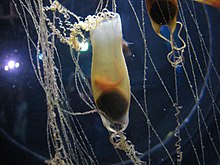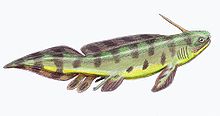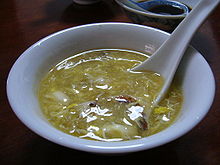Cartilaginous fish
| Cartilaginous fish | ||||||||||||
|---|---|---|---|---|---|---|---|---|---|---|---|---|
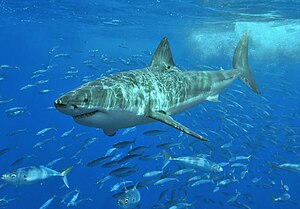
Great White Shark ( Carcharodon carcharias ) |
||||||||||||
| Systematics | ||||||||||||
|
||||||||||||
| Scientific name | ||||||||||||
| Chondrichthyes | ||||||||||||
| Huxley , 1880 |
The cartilaginous fish (Chondrichthyes, χονδριχθύες from ancient Greek χόνδρος chóndros "cartilage" and ἰχθύς ichthýs "fish") are a class of vertebrates (Vertebrata). These include the sharks (Selachii) with more than 500 species, the rays (Batoidea) with over 630 species and the lesser known sea cats (Chimaeriformes) with around 55 species. This means that around 4% of the fish species living today are cartilaginous fish. Almost all cartilaginous fish live in the sea, only a few sharks and freshwater stingrays are found in freshwater.
In contrast to the bony fish , the skeleton of the cartilaginous fish consists of cartilage , which, however , can acquire high strength through the incorporation of prismatic lime . Correct bone tissue is only very rarely formed (in large, old sharks, in vertebral bodies); but also the dentin of the placoid scales (see below) is actually a bone tissue. This is in addition to the usual internal fertilization for cartilaginous fish by means of the from the central part of the ventral fins formed Klasper , one of the main synapomorphies the group.
features
general characteristics

Cartilaginous fish generally grow larger than bony fish. The whale shark ( Rhincodon typus ) with a length of 14 meters and a maximum weight of 12 tons is the largest cartilaginous fish living today and at the same time larger than all bony fish species. However, only 20% of the shark species become over two meters long, half are shorter than one meter. The smallest shark species reach a body length of only about 20 centimeters, the dwarf lantern shark ( Etmopterus perryi ) is the smallest shark species with 16 to 20 centimeters body length and a weight of only 150 grams. The largest ray is the manta ray with a pectoral fin span of up to seven meters and a weight of 1.5 tons, but there are also many small species with a body length and wingspan of less than 20 centimeters. The sea cats are on average about one meter long.
External and internal characteristics
The skin of the sea cats is largely bare, that of the Elasmobranchii (sharks and rays) is covered by tiny, tooth-like placoid scales, with the Holocephalii also having individual placoid teeth or converted placoid teeth in the form of tentacles, which seem to be involved in the corpulation . Cartilaginous fish do not have a swim bladder . The low weight of the cartilage skeleton, a large oil-rich liver and, in many pelagic species, large, wing-like pectoral fins help with buoyancy. Cartilaginous fish usually have five, some original forms also have six or seven gill arches; the gill slits open out freely in sharks and rays and are protected by a gill cover in sea cats . The midgut is (at least largely) designed as a spiral intestine .
Way of life
Almost all cartilaginous fish live in the sea and are therefore marine, only a few, such as the bull shark ( Carcharhinus leucas ), the saw rays (Pristidae) and some stingrays (Dasyatidae) also climb rivers. The freshwater stingrays (Potamotrygonidae) live permanently in freshwater.
Information on the behavior of cartilaginous fish is only available for a few species and comes mainly from the last few decades, in which more intensive research has taken place. Many species are scientifically only known from a few individual catches, so studies on their way of life are usually not available. The focus of scientific research is on sharks and rays of the coastal areas as well as a number of economically interesting forms of the ocean. In addition, there are particularly striking sharks and rays of the ocean due to their size or their importance as potentially dangerous species. Above all, the large number of rather small sharks, rays and sea cats as well as the types of the coastal areas and the deep sea forms have only been little researched and many observations about the way of life and fauna come from interested hobby researchers, who are mainly scuba divers .
nutrition
All cartilaginous fish are carnivorous . Great sharks are among the top predators of the seas and feed primarily on bony fish . Most rays and many shark species feed on hard-shelled crustaceans and molluscs and have specially adapted dentures made from plaster teeth. Some large forms such as whale, giant and basking mouth sharks as well as devil rays are zooplankton eaters (see gill trap ).
Reproduction and development
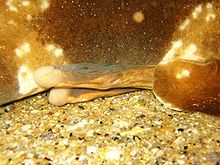
The mating of cartilaginous fish is done by trained in males Klasper , also referred to as Mixopterygia that a similar penis into the sewer to be introduced of the female. Only one of the two clasps is ever used and spread at an angle of about 90 ° for copulation. To fix the clasper in the cloaca, they often have cartilaginous thorns at the tips of sharks and rays and the three-part clasper of the sea cats are equipped with thorn-shaped placoid scales at their tips. The clasper contain a dorsal channel through which the sperm packets are washed into the female genital opening. In sharks, the mucus necessary for this purpose is formed in a special siphon sack, which lies between the abdominal skin and the muscles, and the rays are formed in a clasper gland; directly before copulation, this sack is filled with water and the mucus it contains is thinned accordingly, before it is flushed into the groove together with the sperm through the opening at the base of the clusters.
About 43% of cartilaginous fish lay eggs, i.e. they are oviparous , while the remaining species are ovoviviparous or viviparous , which means they give birth to live young. The oviparity is regarded as the original form of reproduction according to the relationships within the cartilaginous fish. It is found in sea cats , bull head sharks (Heterodontiformes), cat sharks (Scyliorhinidae) and about half of nurse sharks (Orectolobiformes). In addition, the real rays (Rajidae) lay eggs within the rays, although their rectangular shape differs from those of sharks and sea cats; the oviparity is seen by them as a secondary adaptation to their way of life in cold water.
Evolution and systematics
Tribal history
The origin of the cartilaginous fish is obscure, a descent from the Placodermi is no longer suspected today. Skin teeth from the Upper Ordovician 455 million years ago are possibly the first fossil remains of early cartilaginous fish. Also placoid scales that were found in Central Asia and the Untersilur derived are assigned early cartilaginous fish.
The first complete teeth come from the Lower Devonian 418 million years ago, the first intact fossil Doliodus problematicus is 409 million years old, and Pucapampella from the early Devonian of South Africa is possibly even older. Most of the early cartilaginous fish lived in freshwater, in contrast to today's, the Xenacanthiformes are therefore also called freshwater sharks. In the Upper Devonian and Carboniferous the cartilaginous fish experienced their first radiation . Characteristic, three-pointed and very often found shark teeth have been described as " Cladodus ". However, “ Cladodus ” is no longer considered a valid genre today. The cladodonte tooth type occurs in many Paleozoic cartilaginous fish taxa, including in Cladoselache , a very well researched shark-like cartilaginous fish from the Upper Devonian, and in the Symmoriida , which includes the strange stethacanthus , which had an anvil-like fin spine on its back that was toothed on the surface . Other Paleozoic cartilage fish taxa are the Orodontida , which were up to four meters long, and the Eugeneodontida , which had a spiral of regrowing teeth in the lower jaw. Both groups may belong to the Holocephali.
The plate gills first appeared in the Lower Jura . Like their sister group , the Hybodontiformes , which were the dominant cartilaginous fish in the Triassic and Jurassic, they developed from the Ctenacanthiformes .
Systematics
See also: Systematics of cartilaginous fish

The cartilaginous fish are divided into two subclasses, the squill gill (Elasmobranchii) and the Holocephali . The Holocephali mainly contain extinct and only a more recent subgroup, the sea cats. The plate gills include sharks and rays.
-
Cartilaginous fish
- Plate gill (Elasmobranchii)
-
Holocephali
- Sea cats (Chimaeriformes)
The internal system of the Elasmobranchii is still uncertain and controversial. The main issue here is whether the rays form a taxon of the same rank as the sharks or just an order of the squalomorphic sharks . They were traditionally divided into sharks and rays according to their external appearance. In 1996, the Elasmobranchii of de Carvalho and Shirai were divided independently of one another according to morphological characteristics into two monophyletic taxa , the Galeomorphi (Galea near Shirai), which mainly include large open-water sharks, and the Squalea , which includes many bottom-dwelling and deep-sea sharks and also the rays belong. The sharks would therefore only be a paraphyletic form taxon.
In the meantime, however, there are several molecular biological studies that confirm a basal separation ( dichotomy ) of sharks and rays. The morphological correspondences of the squalomorphic sharks with the rays then developed convergent . Since the rays, just like modern sharks, can be traced back to fossil records since the early Jurassic, the origin of the rays at the end of a long evolutionary line of the Squalea is not supported by paleontological data.
In the following tables one version of each of the two different concepts of the internal systematics of the Elasmobranchii is presented.
|
Cartilaginous fish and humans
A number of cartilaginous fish, especially larger species of sharks and rays, are used as food by humans. Around 700,000 tonnes of these animals are caught directly each year, plus around 230,000 tonnes that are bycatch in the fishery. In total, this corresponds to a total of around 8.3 million individuals annually who are killed by human fishing. The use takes place with different intensities; In the case of “fin fishing”, for example, only the fins of mostly large sharks are cut off and used for the preparation of the shark fin soup , the rest of the animal is disposed of as waste (a shark without pectoral fins “dies” miserably).
The shark is particularly common in Asian cuisine. The main ingredient is the shark fin, which is used for shark fin soup or other dishes and in China also as a whole (for this, parts of sharks are dried in traditional Chinese medicine ). But sharks are also used as food in other countries: the Inuit in Greenland dry the meat of the Greenland shark or ferment it into a regional delicacy called “tipnuk”. In Iceland and the Faroe Islands , Greenland Shark is also made edible through fermentation. (Since sharks store urea in their body cells, the meat has to be detoxified.)
Special sharks that are valuable in terms of cuisine are sold under other names, especially in Europe. The industry markets the fish cautiously, but it is often consumed unconsciously. These include in particular the terms "sea eel" and Schillerlocke for dogfish -Preparations and Saumonette and rock Salmon for dogfish . In Europe, rays are mainly used in the Mediterranean area.
Around a quarter of cartilaginous fish species are now at risk of extinction within the next few decades due to overfishing and other human activities. Large species living near the coast are particularly endangered. Among the seven most vulnerable families are five families and two Roche Haifamilien ( angel sharks and thresher sharks ).
Sources and further information
Individual evidence
Most of the information in this article is taken from the sources given under literature, and the following sources are also cited:
- ^ W. Westheide, R. Rieger: Special Zoology - Part 2: Vertebrate or skull animals . Spektrum Akademischer Verlag, Heidelberg 2004, ISBN 3-8274-0307-3 , p. 215
- ^ Robert L. Carroll: Paleontology and Evolution of the Vertebrates . Thieme, Stuttgart 1993, ISBN 3-13-774401-6
- ^ John A. Long: The Rise of Fishes . Johns Hopkins University Press , 1995, ISBN 0-8018-4992-6
- ^ A b Alfred Goldschmid: Chondrichthyes. In: W. Westheide, R. Rieger: Special Zoology. Part 2. Vertebrate or skull animals. Spectrum, Munich 2004. ISBN 3-8274-0307-3
- ↑ a b c Joseph S. Nelson. Fishes of the World . John Wiley & Sons, 2006, ISBN 0-471-25031-7
- ↑ CJ Winchell, AP Martin, J. Mallatt: Phylogeny of elasmobranchs based on LSU and SSU ribosomal RNA genes. Molecular Phylogenetics and Evolution, Volume 31, Issue 1, April 2004, Pages 214-224, doi : 10.1016 / j.ympev.2003.07.010 .
- ^ CJ Underwood: Diversification of the Neoselachii (Chondrichthyes) during the Jurassic and Cretaceous. Paleobiology, 32 (2), 2006. pp. 215-235. PDF
- ↑ NK Dulvy, SL Fowler, JA Musick, RD Cavanagh, PM Kyne, LR Harrison, JK Carlson, LN Davidson, SV Fordham, MP Francis, CM Pollock, CA Simpfendorfer, GH Burgess, KE Carpenter, LJ Compagno, DA Ebert, C Gibson, MR Heupel, SR Livingstone, JC Sanciangco, JD Stevens, S. Valenti, WT White. Extinction risk and conservation of the world's sharks and rays. eLife, 2014; 3 (0): e00590 DOI: 10.7554 / eLife.00590
literature
- Alfred Goldschmid: Chondrichthyes. In: W. Westheide, R. Rieger: Special Zoology. Part 2. Vertebrate or skull animals. Spectrum, Munich 2004. ISBN 3-8274-0307-3
- Volker Storch, Ulrich Welsch: Systematic Zoology . Fischer, 1997, ISBN 3-437-25160-0
- Joseph S. Nelson : Fishes of the World . John Wiley & Sons, 2006, ISBN 0-471-25031-7
- Kurt Fiedler: Textbook of Special Zoology, Volume II, Part 2: Fish . Gustav Fischer, Jena 1991, ISBN 3-334-00339-6
- Michael R. George, Heike Zidowitz: Checklist of the European cartilaginous fish species with scientific and German names . In: Zeitschrift für Fischkunde , Volume 8, Issue 1/2, October 15, 2006, pp. 71–81 ( PDF )
